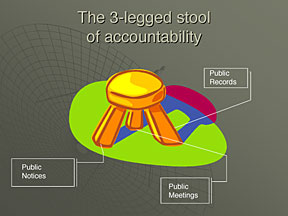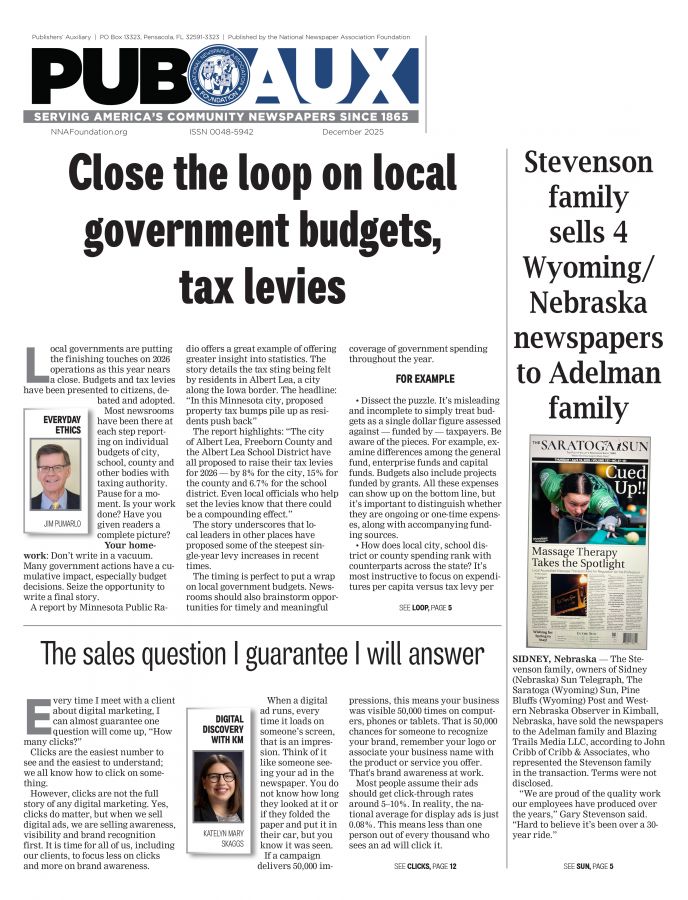Public notice year in review
Public Notice Resource Center & NNA
Jan 1, 2024
2023 was a lot like 2022: A pretty good year marred primarily by the vote of a GOP-dominated state legislature to allow some local governments to publish notices on their own websites in lieu of local newspapers. Last year it was Florida; this year Ohio.
Twenty-one states saw bills in 2023 that would have significantly curtailed newspaper notice, a number that is at the high end of the normal range for these kinds of bills. The only one to pass was Ohio HB-33.
The legislative data this year were similar to those in the recent past in other respects, as well. In total, PNRC tracked about 200 bills that had the potential to affect public notice; 50 were signed into law. Most of these new statutes will have little impact, equally divided between those that will have a marginally positive effect on government transparency and those that will slightly enhance official secrecy.
[Spreadsheet analyzing 2023 public notice legislation available at https://bit.ly/3RroX7l] [Rubric for bill types is available at https://bit.ly/3GGWdSS]
The only consequential new laws enacted last year are briefly summarized below in roughly descending order of their impact. Aside from the bill in Ohio, all were supported by the newspaper industry.
1. LOUISIANA HB-650
(https://bit.ly/3GHtXQ3) This is the first statute requiring notice to be posted on newspaper websites instead of print newspapers, with the transition from hard copy to electronic set to commence in 2027. HB-650 also simplifies and standardizes the state’s fee structure and requires official newspapers to have a website and post notices on it — free of charge until 2027 — and on the LPA statewide site.
2. OHIO HB-33
(https://bit.ly/3tW7xHD) Inserted into the annual budget bill at the last minute, this new law made Ohio the second state to allow some local governments (i.e., municipalities, but not counties, villages or townships) to post many or most of their notices on their own website and social media feed instead of publishing them in a local newspaper or legal journal. Inexplicably, HB-33 also gave municipalities the option to publish notice on the Ohio News Media Association’s statewide public notice website free of charge. Moreover, the bill eliminated or reduced newspaper publication of several specific types of notices at all levels of government, including those relating to bids, delinquent taxes and the environment.
ONMA and newspaper publishers in the Buckeye State now face the challenge of preventing the new law from spreading to other levels of government.
Unfortunately, the potential metastization has already begun with the introduction last month of HB-315 (https://bit.ly/3Nx3TuT), which would allow townships to completely abandon newspaper notice.
3. NORTH DAKOTA HB-1197 AND OREGON HB-3167
These are the first statutes (https://bit.ly/3tb1Vto and https://bit.ly/3uVBmZr, respectively) allowing public notice ads to be published in the e-editions of official newspapers instead of print. Oregon HB-3167 additionally authorizes otherwise non-qualifying papers to provide local notice for up to 12 months in jurisdictions temporarily lacking an official newspaper. It also adds content standards to the public notice law requiring “consistent, regular coverage of local news” and at least 25% of “total news content” to be “locally and originally composed”.
4. GEORGIA HB-254
(https://bit.ly/41DKaQh) This one also adds a content standard (i.e., minimum paid circulation of 100) while temporarily expanding eligibility to publish notice to free-circulation newspapers when there are no papers in a county that meet the paid-circulation requirement. Most importantly for papers in Georgia, HB-254 increases publication fees by 50% — the state’s first fee increase in about 25 years. The bill also establishes a process by which posting a notice on a newspaper or government website, and Georgia Press Association’s statewide site, cures the failure of a print newspaper to publish timely notice submitted by a county or municipality.
5. TEXAS SB-943
(https://bit.ly/46XsfFa) Bills requiring newspapers that publish print notices to also post those notices on their own website and their press association’s statewide public notice site were introduced in four states this year. This is the only one that was approved, making Texas the nineteenth state to enact such a law.
Every new year now poses major challenges for the future of public notice, and 2024 is likely to follow that pattern. Nevertheless, newspaper notice will survive for years to come if newspapers provide effective notice to their communities and adequate customer service to their government clients, and if more publishers learn to advocate on their own behalf directly with public officials.
WISCONSIN REPORT SHOWS LIMITS OF GOVERNMENT PUBLISHING CAPACITY
Almost 40% of the counties, cities, villages and towns in Wisconsin don’t post their local ordinances on a website or, at best, have posted an “obviously incomplete listing of ordinances,” according to a report (https://bit.ly/3RlZpIB) issued this summer by the state’s Department of Administration (DOA).
The agency also noted that many local governments that do post their ordinances on the web make it difficult or impossible to find them or to determine how comprehensive they are.
The report was designed to analyze the interplay between the “comprehensive plans” and local land regulations adopted by local governments. State law requires local governments to update their plans at least every 10 years. It also requires them to maintain consistency between their comprehensive plans and any changes they make to their zoning, subdivision or official mapping ordinances.
“If a local government with an outdated plan wants to rezone land, for example, it must first go through a public planning process to update its comprehensive plan, which could be a time-consuming process,” explained DOA in the report. “If the local government proceeds without an updated comprehensive plan, a citizen or organization could bring a lawsuit to void the action because it lacks consistency with a valid comprehensive plan.”
DOA found that despite those statutory mandates, most of the state’s 1,922 local government units have not comprehensively updated or even amended their plans in the last 10 years. Nevertheless, at least 25% took the risk of passing zoning or subdivision regulations without having a valid comprehensive plan, leaving those regulations vulnerable to being overturned by lawsuit.
Although DOA didn’t explain why so many local governments in the state fail to publish their ordinances online or comply with the state’s Comprehensive Planning Law, their findings strongly suggest it’s a matter of resources. Larger government units usually comply with the mandates; all 72 counties in the state and 93% of the cities post ordinances on their websites. Compliance drops precipitously for villages (69%) and towns (51%), which generally are far less populous and have smaller tax bases and spottier internet access than cities and counties.
Moreover, the 25% of local government units that don’t have a website are all towns (34% have no website) and villages (14%).
These findings suggest most municipalities in the U.S. are unprepared to discharge the publishing duties and acquire the expertise required to provide public notice to their residents via the internet.
The report is a veritable compendium of small-town government dysfunction, perhaps best summarized by what DOA found in the City of Montreal (pop. 807) in Wisconsin. The preface to the code of ordinances (https://bit.ly/3GHEtH5) posted on the city’s website states, “Good democracy requires not only good laws, but laws which are readily available in written form to all who are subject to them, to the public officials and police officers who must administer them and to the judges and attorneys who must interpret and apply them.”
As DOA noted, the code Montreal provides on its website is a “scanned PDF of the original (1989) hardcopy ... posted in a non-searchable format, so (it) does not exactly meet today’s expectations for ‘readily available in written form.’”
That same PDF is still posted on Montreal’s website (https://bit.ly/3GGGZxk) almost four months after the small city was called out in the DOA report.









